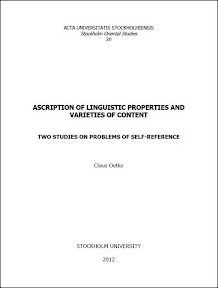Oetke: Ascriptions of Linguistic Properties...
Oetke, Claus:
Ascriptions of Linguistic Properties and Varieties of Content : Two Studies on Problems of Self-Reference / Claus Oetke. - Stockholm : Acta Universitatis Stockholmiensis, 2012. - 307 S. - (Acta Universitatis Stockholmiensis : Stockholm Oriental Studies ; 20)
ISBN 978-91-87235-14-6 (Printausg.)
ISBN 978-91-87235-13-9 (Open Access eBook)
SEK 114,48 (Printausg.)
DDC: 491.201; 181.4
Beschreibung
The dominant topic of this study pertains to the relationship between the possession of properties on the part of linguistic items, such as words, concatenations of words or sentences, and the possibility of truly ascribing those properties to the concerned units. It can be verified that among the qualities which linguistic expressions can exhibit there are some which could be correctly attributed to them only by employing items which (numerically) differ from the pertinent expressions. As various properties exist which exhibit this particular feature the question how different phenomena of the impossibility of self-ascription are related to each other attains relevance. There is evidence to the effect that the existence of linguistic qualities exemplifying the pertinent peculiarity has been realized even in some non-Western philosophical tradition. For that reason the present investigation possesses both historical and problem-oriented ingredients. On the one hand the goal is pursued to substantiate the claim that the phenomenon of impossibility of self-ascription has been recognized in a non-Western tradition, at least with respect to particular linguistic properties. This task is performed by an analysis of a textual segment within a work which has been written in the tradition of linguistic philosophy in India, presumably in the fifth or sixth century AD, and by an attempt to demonstrate that a most coherent argumentative structure can be distilled from the textual segment supposing that it concerns the topic of impossibility of self-ascription with respect to semantic functions. On the other hand the question of how the impossibility of self-ascription regarding particular semantic functions is connected with problems of self-ascription regarding lack of truth constitutes a major concern of the study. It is contended that the latter phenomenon involves specific aspects and that accordingly the thesis insinuated by some scholars that the investigated text could provide a basis for the solution of truth-paradoxes is unwarranted. In view of the fact that the supposition that self-ascriptions of lack of truth always lack the property of expressing a truth is not self-evident it has been endeavoured to support the plausibility of this tenet and to show that this stance need not lead to inconsistencies, if it were assumed that only a particular type of content differing from a linguistically expressed content exhibits the qualities of being definitely true or untrue and of always complying with ‘classical’ inference-rules — in particular modus ponendo ponens and reductio ad absurdum — as well as with a principle according to which a linguistic unit expresses a truth exactly if its content is true. A contention is that the postulation of this type of content need not be made merely ad hoc. The envisaged position implies that the existence of indexical elements is by no means the only factor preventing that linguistic synonymy guarantees identity of truth value and that even linguistic items without deictic ingredients can be simultaneously linked to various types of content. As the investigations also refer to other phenomena suggesting that being simultaneously related to a multitude of contents is not an uncommon feature of linguistic expressions they touch on questions of interpretation and translation and thereby affect some general issues of the humanities. [Stockholm University]
Inhalt
INTRODUCTION. 1
ASCRIPTION OF LINGUISTIC PROPERTIES. 25
1. Statements of linguistic facts. 27
2. Types of failure of self-ascription. 30
3. Ascription of semantic functions and the initial segment of the Saṃbandha-Samuddeśa in the Vākyapadīya. 45
4. The verses 1-29 of the Saṃbandha-Samuddeśa. 57
5. Self-denial of truth. 212
6. Outline of subsequent topics. 231
PARADOXES OF TRUTH AND DIVERSITIES OF CONTENT. 233
REFERENCES. 297
INDEX. 301
Quellen: Stockholm University Library; Stockholm University, Publications
Bildquelle: Bildschirmfoto vom Titelblatt (Quelle: Stockholm University, Publications)
Bibliographie: [1]
Bestelladresse:
Stockholm University Library
SE-106 91 Stockholm
Phone: + 46 (0)8-16 29 52
E-mail: acta@sub.su.se
URL: http://www.sub.su.se
References
- (2012). Ascriptions of Linguistic Properties and Varieties of Content: Two Studies on Problems of Self-Reference. Acta Universitatis Stockholmiensis: Stockholm Oriental Studies; 20. 307 S.
Ähnlich
- Vedic and Sanskrit Historical Linguistics
- Diaconescu: Debating Verbal Cognition
- Samskrta-sadhuta
- Sanskrit Computational Linguistics
- Neti neti
- Mylius: Lehrbuch der Ardhamāgadhī
- Harimoto: God, Reason, and Yoga
- Defining the Indefinable
- Deokar: Subhuticandra's Kavikamadhenu on Amarakosa
- White: The Yoga Sutra of Patanjali

